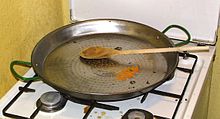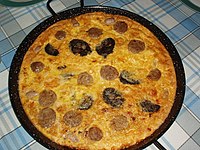Paella
A paella [ pa'eʎa ] is a Spanish rice dish from the pan and the national dish of the Valencia region and the east coast of Spain. The term paella comes from Catalan (around 1892) and has its origin in the Latin word patella (a kind of large plate or flat bowl made of metal). Around 1900 the Valencians adapted the word paella for the metal pan in which their national dish is prepared.
The term paella is now used in Spanish for the dish and for the pan, which is otherwise also known as paellera [pae'ʎeɾa].
The paella is a traditional Valencian dish. Although Spanish cuisine is very regional, paella is very well known throughout Spain. Due to this regional character, however, several variants that differ from the traditional Paella Valenciana are prepared in the various regions of Spain .
The paella (paella pan)
Paellas are large, circular, and very shallow pans . In Spanish households there are often several paellas of different diameters, as the pan should be sized so that the rice is no more than four centimeters high.
For the traditional preparation of rice from the paella on the wood fire, paella pans made of wrought iron or cast iron are mostly used, in Catalonia clay pans are also used occasionally. Paellas made of enamelled steel, stainless steel or Teflon-coated aluminum are available for private use.
Paellas made of wrought iron or thick, pressed sheet metal are not dishwasher-safe. They can rust if they are degreased too much during washing and not dried immediately. After washing, the dried pans are rubbed with olive oil. Rusty pans are cleaned with baking soda , which is rubbed into the paella pan with half a lemon. The simple and traditional method is to clean it with dry sand.
paella Valenciana
The Paella Valenciana consists of rice colored bright yellow with saffron , vegetables and white meat ( chicken , rabbit ). The meat is chopped into bite-sized pieces with the bone. Occasionally small snails are also added. The vegetables used are mostly chopped tomatoes , bajoquetes (green broad beans ) and garrofó (large, flat white beans). It is seasoned with salt , fresh garlic and saffron. (Fresh) rosemary sprigs , which are placed on the rice during the last few minutes and, if necessary, also added to the fire, give an additional Mediterranean taste.
Traditionally, in addition to white kidney beans , firebeans as well as eel , meat from western water vole and duck , paprika and, especially in winter, artichokes were used as additional ingredients . Paellas with seafood are Paella de marisco called.
Nowadays, the yellow color of paella rice is usually achieved by two spices. On the one hand through the traditional azafrán (saffron) and on the other hand through the addition of colorante (a food coloring powder based on calendula), which has almost no taste of its own.
See also Valencian cuisine
preparation
Plenty of olive oil is heated in the pan. If seafood is included, the first thing to do is to sear it and take it out again. Then the meat is seared for 10 minutes, until it is almost cooked. Then add the whole, unpeeled cloves of garlic. Now the whole, unpeeled tomato is rubbed over the meat on a vegetable grater and the green beans, the strips of red peppers and the garrofones are added. The vegetables are braised in the pan for about 10 minutes. Then the rice is added. You mix it with the other ingredients and then pour water or caldo , broth, over it. From now on the paella must no longer be stirred. The paella "sings", makes a bubbling sound. The water and heat from the fire must be such that the water is completely absorbed by the rice when the paella is ready. Then the "singing" stops. You can no longer add water. When the paella is ready, let it rest covered for eight to ten minutes, ideally covered with a kitchen towel. Before eating, the paella is drizzled with lemon juice.
Tradition and history
Traditionally, a paella is prepared on an open, mainly outdoors, pine or almond wood fire on weekends for the whole family. The paella pan rests on an iron tripote , which stands directly in the wood fire. This tradition is still very popular , especially in the Valencia region . Traditionally, paella is eaten straight from the pan with a spoon, rarely a wooden spoon.
Paella is often incorrectly referred to as the Spanish national dish. This is not true, as paella is a traditional dish from the Valencia region. The often offered paella mixta (paella with seafood and meat) is a newer type of paella Valenciana, which Valencians like to call paella de turistas (tourist paella).
Saffron is often not used for paellas , although saffron is not very expensive in Spain, it is colored with food coloring such as E-102 tartrazine . This dye is sold under the name "Colorante alimentario". But there are also suitable, inexpensive paella seasoning mixes with saffron.
Traditional paella
There are many ways to prepare a paella. All paella cooks agree that they are eaten for lunch (around 3 p.m.) and never in the evening because it is too heavy in the stomach. There is also agreement that a paella is prepared with paella rice, preferably arroz bomba , which is grown in the area around Valencia . Long-grain rice is an adequate substitute. Risotto rice, on the other hand, is not suitable for a paella because it is very starchy and, unlike paella rice, becomes very soft and sticky when cooked. The rice grains in the paella should be dry, grainy and not sticky.
Some cooks let the rice trickle over the seared meat and vegetables in a cross shape and then add water or broth. Others cover the finished paella not only with a newspaper, but also with sprigs of rosemary , some not at all. On the other hand, everyone agrees that no water may be added. Some add a dash of beer or red wine. Rice is crucial for the success of a paella. Paella rice arroz bomba requires about twice to two and a half times the volume of water, i.e. two cups of water for one cup of rice grains. When the water is boiling, reduce the heat so that the water does not boil off before the rice is done. Usually the paella is not stirred. The paella is ready when the water has evaporated and the rice is cooked but still firm to the bite. So that the cherished, tasty, fine crust, socarrat , forms at the bottom of the paella dish, cook it for a few more minutes until the bottom layer of rice grains begins to bake on the pan.
Trivia
On March 8, 1992, a paella was prepared in Valencia for 100,000 people. The following ingredients were used: 5,000 kg rice, 6,800 kg chicken, 5,000 kg rabbit, 400 kg duck, 1,000 kg snails, 2,400 kg green beans, 1,400 kg white broad beans, 1,000 kg tomatoes, 150 kg salt, 5 kg paprika powder (mild ), 1 kg of Colorante, 1,000 liters of oil and 12,500 liters of water. The pan had a diameter of twenty meters, a capacity of 210,000 liters, a sheet thickness of eight millimeters and had a total of 4,000 meters of weld seams; the total weight of the filled paellera was around 30,000 kilograms and was supported by 90 support pillars. This paella was included in the Guinness Book of Records .
Variations
Paella is a variant of the countless rice dishes ( arroces ) that are served in País Valencià (the first form is in Spanish and the second in Catalan):
- Paella de marisco / paella de marisc (seafood paella): With seafood and / or fish cooked
- Paella mixta / Paella de carn i peix (Mixed Paella): Prepared with meat and seafood (see above)
- Paella de verdura (vegetable paella) Vegetarian paella
- Fideuà (fi-deua): Here, instead of rice , small noodles are used
- Arroz al horno / Arròs al forn (rice in the oven): preparation in the oven
- Arroz con costra / Arròs amb costra (rice with crust): Preparation like Arroz al horno , but with an egg on the surface
- Arroz en la olla / Arròs d'olla (rice in a pot): preparation in a saucepan on the stove
- Arroz negro / Arròs negre (black rice): typical dish from the Catalan region. The rice is colored with squid ink .
Web links
Individual evidence
- ↑ Guinness World Records, GWR spotlight on Spain, Largest Paella (2007) ( Memento from June 5, 2011 in the Internet Archive ) (English)










